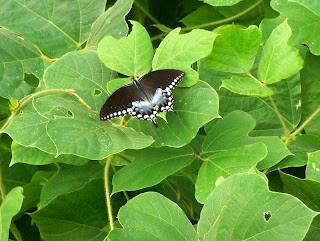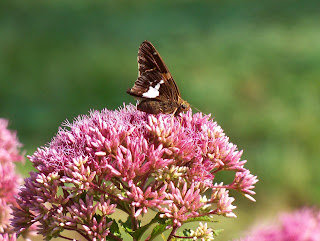The key feature here is on the underside of the wing, that "comet" looking smear that replaces one of the inner orange spots. Similar swallowtail butterflies include the dark morph of the Easter Tiger Swallowtail, the Black Swallowtail, and the Pipevine Swallowtail.
It is thought that the black swallowtails as a group benefit from mimicry of the Pipevine Swallowtail because it is distasteful and poisonous because of the Pipevine its caterpillars eat.
A dark swallowtail from the beach (on Kudzu), seems to be about the same on the upperside.
And another butterfly from the beach which clearly shows the Spicebush Butterflies diagnostic comet. But at the same time, I see plenty of bright yellow Eastern Tigers flitting about.
I also know we must have Black Swallowtails around somewhere because Georgia has found their distinctive caterpillars eating our dill.
Another one that I have been seeing lots of lately, the Silver Spotted Skipper. They are quite abundant around the flower beds at work, at home, and I've even seen a few at the beach.

A more common skipper butterfly. These are the most common butterfly around the gardens, with the distinctive way they hold their wings to show anterior and posterior wings. They vary from nearly all brown to this orange one, and could be several different species for all I can tell.
Many species of skippers look frustratingly alike. For example, some species in the genera Amblyscirtes, Erynnis (duskywings) and Hesperia (branded skippers) cannot currently be distinguished in the field even by experts. The only reliable method of telling them apart involves dissection and microscopic examination of the genitalia, which have characteristic structures that prevent mating except between conspecifics.I've noticed a fair number of these pretty little Pearl Crescents around as well. I noticed them in the lawn, and all over the Joe Pye Weed. They're fast little buggers, and I wasted a lot of pixels trying to get even these few half decent shots.
Showing the underside of the wings.
UPDATE: Just to add to the confusion regarding the dark swallowtails, I encountered this beautiful specimen in the back woods, determined to sip nectar out of these Devil's Walking-stick flowers. It was quite engaged in that and allowed me lots of shots. This is a shot from above, showing the beautiful blue iridescence.
From beneath, you can see the orange spots, in two rows, although the inner one is rather faint, and no sign of the "Spicebush Comet." After staring at pictures for a hour or so, I've reluctantly come to the best guess that it really is a black morph of the Eastern Tiger Swallowtail, but don't anyone use this ID for anything important!
There was a yellow Eastern Tiger Swallowtail in the area (look at the scratches in the top photo), and it and this butterfly would seem to fight, or maybe try to have, or avoid sex, who knows. This butterfly was so oblivious, I literally reached out and grabbed it to take a couple of clear shots of the underside of the wing to help me ID it. I released it a few moments later only slightly worse for wear, and it went back to sipping nectar immediately.










No comments:
Post a Comment